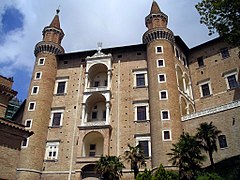Ducal Palace of Urbino
| Ducal palace of Urbino | |
|---|---|
| Palazzo Ducale di Urbino | |

The Palace's Façade.
|
|
| General information | |
| Status | now used as a museum, National Gallery |
| Type | Palace |
| Location | Urbino, Italy |
| Address | Piazza Duca Federico |
| Coordinates | 43°43′24″N 12°38′16″E / 43.723333°N 12.637778°ECoordinates: 43°43′24″N 12°38′16″E / 43.723333°N 12.637778°E |
| Construction started | 1454 |
| Client | House of Montefeltro, House of Della Rovere |
| Website | |
| Official name | Palazzo Ducale: Centro storico di Urbino |
| Type | Cultural |
| Criteria | ii, iv |
| Designated | 1998 (30th session) |
| Reference no. | 828 |
| State Party | Italy |
| Region | Europe |
The Ducal Palace (Italian: Palazzo Ducale) is a Renaissance building in the Italian city of Urbino in the Marche. One of the most important monuments in Italy, it is listed as UNESCO World Heritage Site.
The construction of the Ducal Palace was begun for Duke Federico III da Montefeltro around the mid-fifteenth century by the Florentine Maso di Bartolomeo. The new construction included the pre-existing Palace of the Jole. The solid rock hillside salient was impregnable to siege but was problematic for carving out the foundation of a palace. Thus, a prominent fortress-builder, Luciano Laurana, from Dalmatia, was hired to build the substructure; but Laurana departed Urbino before the living quarters of the palace were begun. After Laurana, the designer or designers of the Ducal Palace are unknown with certainty. Leading High Renaissance architect Donato Bramante was a native of Urbino and may have worked on the completion of the palace.
The Ducal Palace is famous as the setting of the conversations which Baldassare Castiglione represents as having taken place in the Hall of Vigils in 1507 in his Book of the Courtier.
The palace continued in use as a government building into the 20th century, housing municipal archives and offices, and public collections of antique inscriptions and sculpture (the Galleria Nazionale delle Marche, see below). Restorations completed in 1985 have reopened the extensive subterranean network to visitors.
The Ducal Palace featured several rooms that reflect Federico's devotion to Classical and humanistic studies and served his daily routine, which included visiting the palace's lararium and reading Greek literature. These learned and explicitly pagan touches were atypical of a medieval palazzo.
...
Wikipedia
